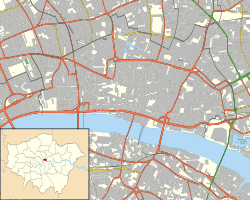
Back Baynard’s Castle German טירת ביינארד HE Baynard's Castle Italian Baynard’s Castle NB Замок Байнардс Russian Baynard's Castle Swedish Baynards qasri Uzbek
| Baynard's Castle | |
|---|---|
| Part of the Fortifications of London | |
| Blackfriars, London, England | |
 The first Baynard's Castle | |
| Type | Castle, later mansion |
| Site history | |
| Built | Before 1017 |
| Materials | stone |
| Demolished | 1666 |
| Garrison information | |
| Occupants | English royalty |
Baynard's Castle refers to buildings on two neighbouring sites in the City of London, between where Blackfriars station and St Paul's Cathedral now stand. The first was a Norman fortification constructed by Ralph Baynard (fl. 1086), 1st feudal baron of Little Dunmow[1] in Essex, and was demolished by King John in 1213. The second was a medieval palace built a short distance to the south-east and later extended, but mostly destroyed in the Great Fire of London in 1666. According to Sir Walter Besant, "There was no house in [London] more interesting than this".[2]
The original castle was built at the point where the old Roman walls and River Fleet met the River Thames, just east of what is now Blackfriars Station. The north wall of the castle used as its foundation the Roman-era river wall from the 3rd century, distinguished by a tile-course of Roman brick.[3][4] The Norman castle stood for over a century before being demolished by King John in 1213. It appears to have been rebuilt after the Barons' Revolt, but the site was sold in 1276 to form the precinct of the great Blackfriars' Monastery.
About a century later, a new mansion was constructed on land that had been reclaimed from the Thames, south-east of the first castle. The house was rebuilt after 1428, and became the London headquarters of the House of York during the Wars of the Roses. The accession of King Edward IV was agreed and proclaimed in the castle on 3 March 1461.[5]
The house was reconstructed as a royal palace by King Henry VII (1485–1509) at the end of the 15th century, and his son Henry VIII gave it to Catherine of Aragon on the eve of their wedding. In 1551,[6] after Henry's death in 1547 and during the reign of the infant King Edward VI, the house was granted to Earl of Pembroke (1501–1570), brother-in-law of Henry's widow, Queen Catherine Parr. Pembroke built a large extension around a second courtyard in about 1551. The Herbert family took the side of Parliament in the English Civil War, and after the 1660 Restoration of the Monarchy the house was occupied by Francis Talbot, 11th Earl of Shrewsbury, a Royalist. Baynard's Castle was left in ruins after the Great Fire of London in 1666, although fragments survived into the 19th century. The site is now occupied by a BT office called Baynard House and the castle is commemorated by Castle Baynard Street and the Castle Baynard Ward of the City of London.
- ^ Sanders, I.J. English Baronies: A Study of their Origin and Descent 1086–1327, Oxford, 1960, p.129
- ^ Besant, Sir Walter (1903), The Thames, London: A. & C. Black, pp. 84–7
- ^ Perring, Dominic (1991). Roman London (2001 ed.). London: Routledge. p. 102. ISBN 9781852640392.
- ^ Maloney, John (January 2024). "The DUA Legacy". British Archaeology. No. 194. Council for British Archaeology. p. 44.
- ^ Edward IV by Charles Ross (1974), p.34
- ^ G. E. Cokayne, The Complete Peerage, n.s., Vol.10, p.406, note f
